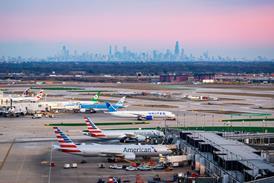By Graham Warwick in Washington DC
Block 2 version of US Navy fighter set to become first to use active array for electronic attack duties
Boeing's F/A-18E/F Block 2 Super Hornet is set to become the first fighter to use its active electronically scanned array (AESA) radar for electronic attack, with a planned software upgrade to allow its array of transmit/receive (T/R) modules to be used as a powerful directional jammer.
Under a "sensor integration" plan being drawn up, the Raytheon APG-79 AESA will be linked to the Raytheon ALR-67 radar warning receiver (RWR) via the fighter's fibre-optic network switch. The radar's ground mapping capability will then be used to pinpoint emitters detected by the RWR.
"This will allow us to begin single-ship geolocation of emitters," says Capt BD Gaddis, US Navy F/A-18 programme manager. The F/A-18E/F's BAE Systems ALQ-214 electronic countermeasures suite will also be integrated so the aircraft can jam emitters. "We will put the -214 jamming signal through the AESA T/R modules to put power on to the emitter," he says.
Although the capability has been widely discussed, it appears the Block 2 Super Hornet will be the first aircraft able to use its AESA for electronic attack. Rival radar manufacturer Northrop Grumman says its APG-77(V)1 and APG-81 AESAs for the Lockheed Martin F-22 and F-35, respectively, will have the capability, but it is not in currently funded plans.
Funding will determine when the sensor integration upgrade takes place, with the capability planned for the budget cycle beginning in fiscal year 2010. The USN is now selecting F/A-18E/F upgrades for funding beginning in FY08, Gaddis says, with candidates including an infrared search-and-track sensor; high off-boresight capability for the AIM-120 AMRAAM air-to-air missile; datalinks for the AIM-9X air-to-air missile and JSOW stand-off weapon; night vision capability for the JHMCS helmet-mounted display; and an AESA electronic counter-countermeasures upgrade.
To pave the way for sensor integration, Boeing has been funded to upgrade the F/A-18E/F's advanced mission computer (AMC). The new Type 3 AMC will be fielded beginning next year, and the navy plans to upgrade AESA-equipped aircraft, taking the Type 2 AMCs out and retrofitting them to older non-AESA Super Hornets to achieve a single software standard across the fleet.
Under current plans, the USN will end up with 406 AESA-equipped Super Hornets, including EA-18G Growler dedicated electronic-attack variants. This number includes 135 earlier Block 2 aircraft that will be retrofitted with the radar from 2010, Gaddis says. The first AESA-equipped squadron is working up for fleet deployment later this year.
Source: Flight International






















